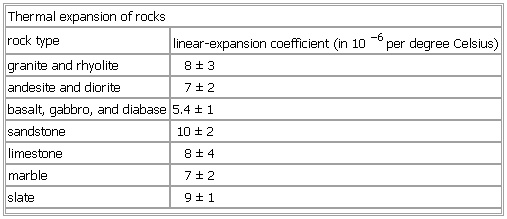Thermal expansion of rocks
- Thermal expansion of rocks
-
Thermal expansion of rocks
rock type linear-expansion coefficient (in 10−6 per degree Celsius)
granite and rhyolite 8 ± 3
andesite and diorite 7 ± 2
basalt, gabbro, and diabase 5.4 ± 1
sandstone 10 ± 2
limestone 8 ± 4
marble 7 ± 2
slate 9 ± 1
See as table:
* * *
Universalium.
2010.
Look at other dictionaries:
Thermal shock — is the name given to cracking as a result of rapid temperature change. Glass and ceramic objects are particularly vulnerable to this form of failure, due to their low toughness, low thermal conductivity, and high thermal expansion coefficients.… … Wikipedia
rock — rock1 rockless, adj. rocklike, adj. /rok/, n. 1. a large mass of stone forming a hill, cliff, promontory, or the like. 2. Geol. a. mineral matter of variable composition, consolidated or unconsolidated, assembled in masses or considerable… … Universalium
Rock — /rok/, n. a male given name. * * * I In geology, a naturally occurring and coherent aggregate of minerals. The three major classes of rock igneous, sedimentary, and metamorphic are based on the processes that formed them. These three classes are… … Universalium
Earth Sciences — ▪ 2009 Introduction Geology and Geochemistry The theme of the 33rd International Geological Congress, which was held in Norway in August 2008, was “Earth System Science: Foundation for Sustainable Development.” It was attended by nearly… … Universalium
Weathering — This article is about weathering of rocks and minerals. For weathering of polymers, see Polymer degradation and Weather testing of polymers. Weathering is the breaking down of rocks, soils and minerals as well as artificial materials through… … Wikipedia
mountain — mountainless, adj. /mown tn/, n. 1. a natural elevation of the earth s surface rising more or less abruptly to a summit, and attaining an altitude greater than that of a hill, usually greater than 2000 ft. (610 m). 2. a large mass of something… … Universalium
silica mineral — Any of the forms of silicon dioxide (SiO2), including quartz, tridymite, cristobalite, coesite, stishovite, melanophlogite, lechatelierite, and chalcedony. Various kinds of silica minerals have been produced synthetically. * * * Introduction… … Universalium
Expanding Earth theory — The Expanding Earth theory is an attempt to explain the position and movement of continents (continental drift) on the surface of the Earth. The expanded earth theory (and plate tectonics) incorporates the appearance of new crustal material at… … Wikipedia
Plate tectonics — The tectonic plates of the world were mapped in the second half of the 20th century … Wikipedia
Helium — otherusesHelium (He) is a colorless, odorless, tasteless, non toxic, inert monatomic chemical element that heads the noble gas group in the periodic table and whose atomic number is 2. Its boiling and melting points are the lowest among the… … Wikipedia

